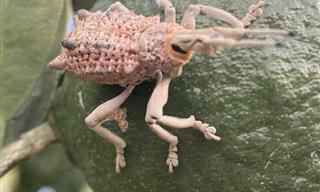
When winter is at its height, it’s hard to think of something set to happen in the spring or summer as very relevant. However, the warmer seasons are only a few months away and experts expect a rare phenomenon to occur in 15 states across the USA this year. For the first time since 2004, millions of cicadas will re-emerge from underground and swarm the country.
The cicada swarm in question is known as Brood X, or the Great Eastern Brood of periodical cicadas. Unlike the more common annual cicadas, which are green, periodical cicadas have black bodies and bright red eyes. Although these insects can look intimidating due to their size (2.5" in length with a 3" wingspan) and ear-piercing buzz, they are mostly harmless.

Image Source: Wikimedia Commons
“The end of May through June, it can get pretty loud – if you are in an area where they are numerous, there can be hundreds of thousands, or millions, of them,” said Howard Russell, an entomologist (insect scientist) at Michigan State University, to USA Today. The states that are expected to see the emergence of the periodical cicadas are Delaware, Georgia, Illinois, Indiana, Kentucky, Maryland, Michigan, North Carolina, New Jersey, New York, Ohio, Pennsylvania, Tennessee, Virginia, West Virginia, as well as Washington, D.C.
The Brood X cicadas emerge en-masse every 17 years when the soil temperatures reach 64 degrees Fahrenheit (18°C), but they can delay their emergence by a few days if the weather is rainy, or otherwise sub-optimal. This time-cycle is one of nature’s great mysteries. Experts are yet to find a definitive answer as to why periodical cicadas aren’t triggered to resurface in, say, the 15th or the 16th spring.
But just because the bugs cannot be seen doesn't mean they are in hibernation. They have been living underground, feeding on sap from tree roots. While living below the surface, the cicadas exist in “nymph” form with white bodies and no wings. It takes about 5 days after their emergence for their exoskeleton to harden and turn black.
The distinctive buzzing noise created by the swarm is due to the male insects trying to attract a mate. After mating, female cicadas will lay eggs in soft, new twigs, using a sharp organ called an ovipositor to cut into the branches and place her fertilized eggs inside. That makes the periodical cicadas quite harmful for tree nurseries and orchards.

“You can’t spray enough pesticide to kill them all without also wiping out everything else in the environment,” Cooley said. What is the solution, then? According to Cooley, it’s putting nets or bags over trees for the period of time the cicadas are active, until around the beginning of July. The eggs hatch in six to ten weeks. The tiny nymphs fall on the ground, burrowing themselves into the soil, and so begins another 17-year cycle.
This is pretty much the only threat the cicadas pose. Their loud buzz may be bothersome, but besides that, they are harmless - they aren’t drawn indoors and they don’t bite.
Apparently, the most common question people have about the cicadas is how to kill them. But Cooley and other experts are urging people to refrain from doing that. "The answer is: don't," he said. "They are one of our natural wonders. Enjoy them while you have them."
Share this information with friends and family!

This Rare Jellyfish Was Only Seen Twice
This rare jellyfish was only ever seen twice. Now we have it caught on video.
 8:13
8:13
These Artists Turn Musty Old Shoes Into Colorful Art
They make these sculptures by hand, and this video will show you their artistic process.

Pack Up and Join Along As We Explore Utah's Landscape
If you enjoy traveling in nature, here are 10 geological oddities you wouldn't want to miss when traveling through Utah.

Watch the Terrifying Eruption of a Raging Volcano
Incredible photos of the eruption of the Taal volcano in the Philippines.
 10:32
10:32
This is How Mountain Goats Defy Physics and Gravity
They're known to be able to defy the laws of physics, and today we'll discover exactly how they do that.
 10:19
10:19
Lift Your Spirits With These Animal Rescue Stories!
Forget about the damsel in distress. This time, nature calls, and we must answer!

These Horses All Have the Most Amazing Hair!
These horse breeds all have an amazing hair! Enjoy getting to know some of the world's most beautiful horse breeds, along with some facts.

9 Incredible Animals You Weren’t Taught about in School...
Lesser known animals from around the world that deserve more recognition

These Natural Phenomena Will Leave You Completely Aghast
Some of the natural phenomena in this world are completely unique and really need to be seen to be believed. Here are 25 phenomena

Breathtaking! Nature Has Never Looked This Beautiful!
Check out some of the finest photos from National Geographic's 2017 'Nature Photographer of the Year' awards.

16 Stunning Gardens I'd Be Delighted to Stroll Through...
A stunning collection of 16 different landscape designs that will excite every nature lover out there.

You Won't Believe the Equine Wonder in These Horse Photos
Wiebke Haas captures some of the world's most beautiful horses strutting their proud stuff in this superb collection of equine majesty.

10 of the Largest Living Birds in the World
Check out this list of the largest and heaviest birds that inhabit our planet today.

Australia is the Land of the Most Bizarre Creatures!
Australia is the land of the most bizarre creatures!

How Do Animals Communicate with Each Other? Fascinating!
Discover how some animals communicate with one another... fascinating!
 7:26
7:26
Learn the True Art Behind the Bonsai Tree
Ryan Neil is an expert in the art of shaping Bonsai Trees, and will take you on a journey into yourself through nature!

These Wholesome Animal Titbits Will Make You Smile
Here are some adorable animal facts that will keep you smiling all day.

15 Pictures Depicting the Rare Wonders of Nature
In this article, we display 15 unique photos of various natural phenomena - from rare eye colors to beautiful rock formations, and even albino plants.

Hilarious! Nobody Tells Mother Nature What to Do!
Here are 18 ironic photos that prove that nature doesn't care about what people want!

The Most Incredible Animal Friendships!
in reality, animals can sometimes remind us of childhood stories and tv programs - sometimes the unlikely friendships are indeed made by animals, and here's the proof:

These Flowers Capture a Starry Night On Their Petals
These wonderful flowers appear to have the night sky captured in their very petals. View some stunning photos of them and learn more about them.
 15:35
15:35
The Internet's Burning Questions About Biology, Answered
Watch biologist Thor Hanson answer some fascinating questions about biology in this video.

Nature is Amazing in So Many Ways – 20 Beautiful Pics
The wonders of nature never cease to amaze us. Check out some glorious nature pics here.

Italian Wildlife Should be Talked About a Lot More!
Join us on a journey to Italy’s amazing wildlife.

22 of Nature Photography's Most Exquisite Moments!
The NG website has a daily photo of the day page, from which we've selected 22 incredible examples of nature's undeniable and breathtaking beauty. Undoubtedly, you also deserve to enjoy these amazing pictures from the last few months.

These Award-Winning Wildlife Photos Are Phenomenal
View some of the best entries from the 2017 edition of GDT's ‘European Wildlife Photographer of the Year' competition. Take a look.
 4:16
4:16
Experience Pinnacles National Park in Crisp 4K Resolution
Check out this incredible time lapse video of California's Pinnacles National Park, which was filmed in crisp 4K resolution.

Life in the Treetops: A Look at Tree-Dwelling Animals!
Let’s take a deep dive into the secret lives of arboreal animals and the challenges they face in their natural habitat.
 4:28
4:28
Meet the Giant Cassowary – The Modern-Day Dinosaur
Meet the most dangerous bird on Earth, the giant cassowary, that is also regarded as a modern-day dinosaur.
 3:01
3:01
Fly Through the Most Royally Stunning Castles of Europe!
I love this wonderful drone footage of the great castles and palaces of old Europe so much I just had to share it with you. It's a true life fairytale.

17 Utterly Beautiful Photos of Japan's Cherry Blossoms
The sight of blooming cherry blossoms is synonymous with springtime Japan. Take a look at these beautiful photos to remind you what a wonderful season this is.
 1:00:43
1:00:43
Dive Deep Into the Vast Open Serengeti in 4K
Watching wild animals in their natural habitats is as exciting as nature gets. Enjoy the journey!
 7:37
7:37
Visiting the Tallest Moutain in NZ: Mount Cook Adventure!
Don't miss out on this opportunity to witness the splendor of this unique destination.
 3:44
3:44
This Bird of Prey Is the Undisputed King of the Skies
The Peregrine falcon is far from the average avian predator as this awesome video proves!

A Photo Guide to Beautiful Birds of Prey
A comprehensive photo-guide of common and rare birds of prey.

8 Members of the Animal World Who Thrive In Their Solitude
Here's a look at some of the most interesting solitary animals in the world who thrive in their solitude.

GALLERY: You've Never Seen Such Crazy Weather Pics Before!
Check out this incredible collection of extreme weather photos.

The Most Frightening and Bizarre Creatures of the Ocean
Terrifying and alien creatures of the dark depths of the ocean

Incredible Undersea Photography: 16 Award-Winning Pics
Check out the breathtaking winners of the Underwater Photographer of the Year 2023 contest.
 8:54
8:54
Animal Leanring: How Cats Apologize to Humans
Many people think cats don't know how to apologize or feel regret. However, cats harbor a depth of emotions that might surprise you.
 6:33
6:33
Graceful Margay: The Elusive Feline of the Rainforest
Meet the Margay, the most arboreal cat in the world.

15 Charming Close-Ups of Cold-Blooded Creatures
You've never seen lizards, snakes, or frogs like this before.

This Photographer Captured the Majesty of Maine Coon Cats
Photographer Robert Sijka is a cat aficionado, and he also happens to be an excellent photographer. Take a look at his work with Maine Coon cats.

These Creatures Are So Scary You'll Be Happy They're Extinct
Once you read more about these extinct animals - you'll be happy you won't have to see them in real life.

16 Photos That Showcase Our Planet’s Breathtaking Beauty
Check out these unbelievably picturesque photos from around the world.

These Cute Animal Encounters Took People by Surprise
Enjoy these touching images of harmony between animals and humans.

These Rare Mushrooms Can Glow In the Dark
Only about 70 mushroom species out of 14,000 have this beautiful and rare ability.


